Porto-North-Portugal.com
The best independent guide to Porto
Porto-North-Portugal.com
The best independent guide to Porto
Porto to Lisbon: Is train or bus travel better in 2026?
Porto and Lisbon are the two largest cities in Portugal, with each being a fantastic tourist destination in its own unique way. Lisbon is the vibrant capital of Portugal, which is also the location of the country’s main international airport.
For your journey from Porto to Lisbon, there are many different transport options, including express trains, intercity buses, or by car along the A1 toll expressway.
Each mode of transport has its own advantages, but all take around 3 hours to cover the 310km distance between the two cities.
Train travel is generally more comfortable, with fares starting from €26.85, whereas express buses have slightly longer journey times but offer fares as low as €7.99.
This guide details the best ways to travel from Porto to Lisbon, providing links to transport companies and offering some useful travel advice.
Related articles: Introduction to Porto - Our Lisbon guide
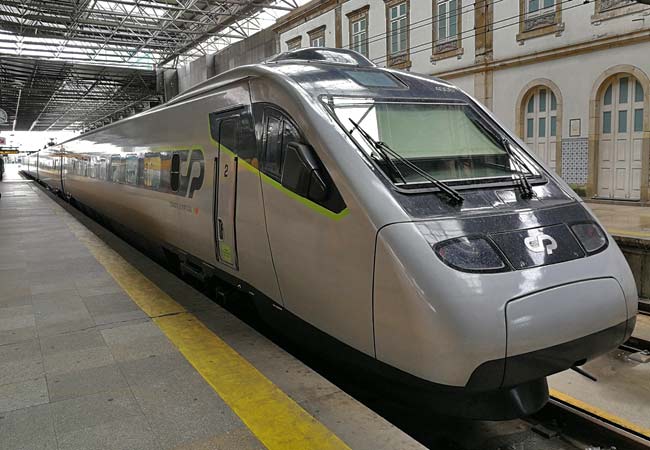
The express train service between Porto and Lisbon is fast and modern.
Summary of travel from Porto to Lisbon
There are many possible ways to travel between Porto and Lisbon, with options including:
FlixBus
The cheapest and one of the best options for travelling from Porto to Lisbon, with over 25 daily departures. The route between Porto and Lisbon is direct and takes only 3 hours and 15 minutes. Fares vary depending on demand, but can be as low as €7.99.
In Porto, FlixBus leaves from the Campanhã bus station and terminates at the Oriente bus station in Lisbon. The only downside is that their low-cost business model needs the buses to be nearly full, and they will often have at least 80 per cent of the seats sold. For bookings, see their website FlixBus
Comboios de Portugal (CP)
Express train travel from Porto to Lisbon is more expensive than bus travel, but the seats are more spacious and comfortable. There are two standards of train: the faster and more modern Alfa Pendular (AP) and the slightly cheaper Intercidades (IC) intercity.
The fastest train service, the Alfa Pendular, takes just 2 hours and 50 minutes, while seats on the Intercidades cost €26.85 for an adult single. Train travel between Porto and Lisbon is very luxurious, especially in first class, making it a great choice if you’re a higher-end traveller.
Trains depart from Porto's Campanhã train station and all trains stop at Oriente station in Lisbon, with most terminating at Santa Apolónia train station. For the latest timetables and ticket booking, please see the Comboios de Portugal website: www.cp.pt/
Rede Expressos
This is the main intercity bus company of Portugal, which provides direct bus services from Porto to Lisbon. Its fares are typically more expensive than those of FlixBus, but are still much cheaper than train travel.
Rede Expressos buses are generally less busy than the comparable FlixBus services; for instance, if you’re travelling solo, it’s likely you won't have someone sitting next to you. Rede Expressos have over 20 daily departures from Campanhã bus station to Lisbon, and the journey time is 3 hours 15 minutes.
www.
Driving along the A1 expressway
Porto and Lisbon are connected by the A1 Expressway, and the journey takes approximately 2 hours and 50 minutes to drive, without including any time in traffic in the cities. The A1 is a toll expressway, with a surprisingly high toll of €22.50. When petrol is also factored in, this makes the journey by car similar in cost to the train fare for two people.
Popular destinations on the route include Aveiro, Coimbra and Tomar, as well as Nazaré and Óbidos if you detour via the A8.
Private Transfer
Transfers in Portugal are expensive, with a journey from Porto to Lisbon costing around €400. This cost is significantly higher than that of the train, which is far more comfortable. A private transfer is available through GetYourGuide.com
Travel by Plane
Both Porto and Lisbon have airports, however it is impractical to fly this short distance. When combining flight time and airport transit times, it is significantly quicker to travel by train or bus.
Advice: While many third-party websites sell train and bus tickets, it is advisable to book directly with the transport companies. Buying directly will reduce booking fees and ensure each company is more accommodating if there are issues.
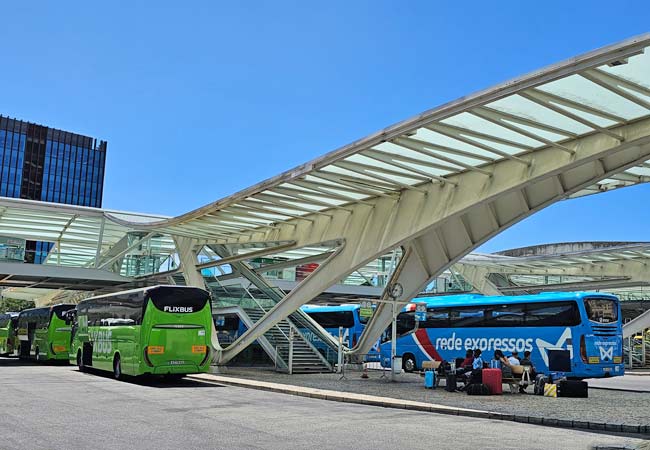
Rede Expressos and FlixBus services at Oriente bus station in Lisbon.
How best to travel from Porto to Lisbon
All of the methods detailed above have their advantages and disadvantages, and the best choice for you will depend on your priorities.
If you are a budget or cash-conscious traveller, then FlixBus is the best option for you. However, if you are an older visitor or prefer comfort over price, then train will be the better choice.
We do not recommend hiring a car solely for the journey from Porto to Lisbon. Driving along the A1 expressway is very easy, but navigating the cities can be extremely challenging due to heavy traffic, confusing road layouts and limited parking.
Opting for a private transfer between Porto and Lisbon can be unnecessarily expensive, given that first-class train travel is much more comfortable.
Insight: Given the distance and length of the journey, it is not advisable to consider Lisbon as a day trip from Porto. It is always recommended to spend at least three days in the Portuguese capital.
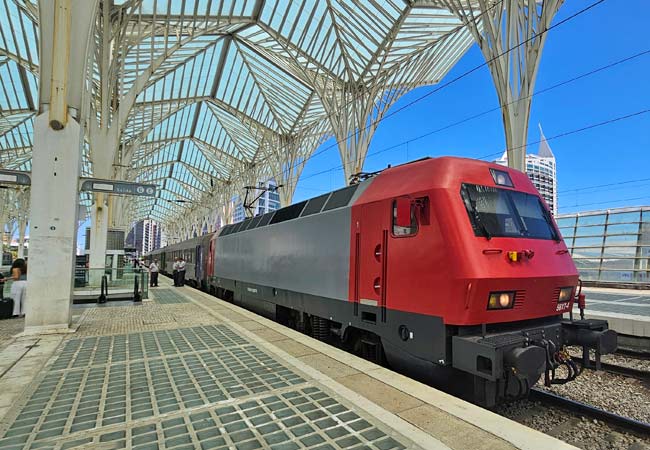
The Estação do Oriente in Lisbon, is ultra-modern and in the Parque das Nações district of Lisbon
Book your seats in advance!
If there's one key takeaway from this article, it should be to book your tickets (for both bus and train) well in advance of your journey. Booking in advance will not only save you money but also secure your seats, as popular services often sell out during peak season.
Express train services between Porto and Lisbon have a limited number of seats, and once sold out, no more tickets will be available. There is no standing allowed on the Alfa Pendular or Intercidades trains.
Buses between Porto and Lisbon can get extremely busy during popular times, such as Friday evenings and weekends.
Both FlixBus and Rede Expressos use dynamic pricing, where seat prices start low and then increase with demand. FlixBus is generally cheaper than Rede Expressos; however, it is always worth checking both websites.
The following sections will detail bus and train travel in depth.
Porto to Lisbon by bus
Intercity bus travel in Portugal is safe, and the buses are modern and clean.
Bus travel is the cheapest method of travel from Porto to Lisbon, and the journey times are similar to the Intercidades trains (3 hours and 15 minutes).
FlixBus provides the lowest fares, and the price of bus travel has significantly fallen in Portugal since it began operating. The downside to these low prices is that FlixBus buses are often more than 80 per cent full.
Rede Expressos is the main intercity bus company of Portugal, serving every major town within the country. The bus company is a conglomerate of other smaller bus operators, and certain Porto to Lisbon routes may be served by Renex.
Between FlixBus and Rede Expressos, there are over 50 daily departures from Porto to Lisbon, and fares can be as low as €7.99 if booked far enough in advance.
The buses have space for luggage, which is stored in compartments on the side of the bus. Onboard, the buses offer USB chargers and even WiFi, but they do not have toilets.
For the latest timetables and to purchase tickets, please visit the Rede Expressos or FlixBus websites:
Rede Expressos - rede-expressos.pt/
Flixbus - FlixBus
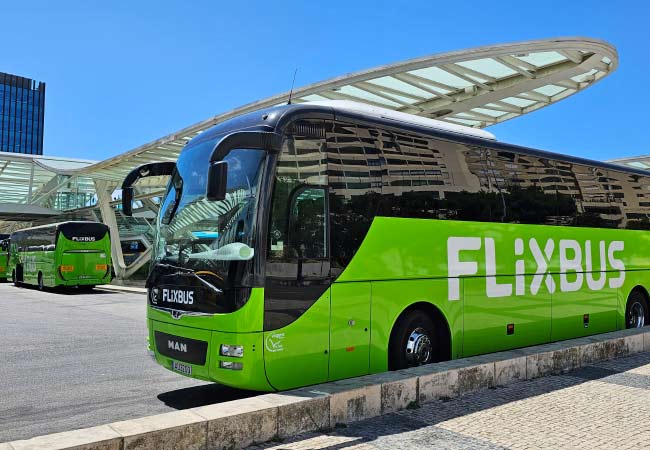
Bus stations at Porto and Lisbon
Porto has a single intercity bus terminal at Campanhã, which is also connected to the city's main train station.
The Terminal Intermodal de Campanhã (often abbreviated to TIC or simply referred to as Campanhã) is situated to the east of Porto, at GPS 41.151, -8.582 (link to Google Maps). The bus station is connected to the metro; however, a connection at Trindade is necessary if you are travelling from the historic centre of Porto.
For this journey from your accommodation to the bus station, it's probably easier to take an Uber or Bolt (€4 to €5) or a taxi (€7 to €9), especially if travelling with heavy luggage.
Campanhã is a busy bus station, with over 40,000 people passing through daily and more than 700 departures. It is a modern complex, with ticket offices, shops and toilet facilities on the first floor and the bus departure bays on the ground floor.
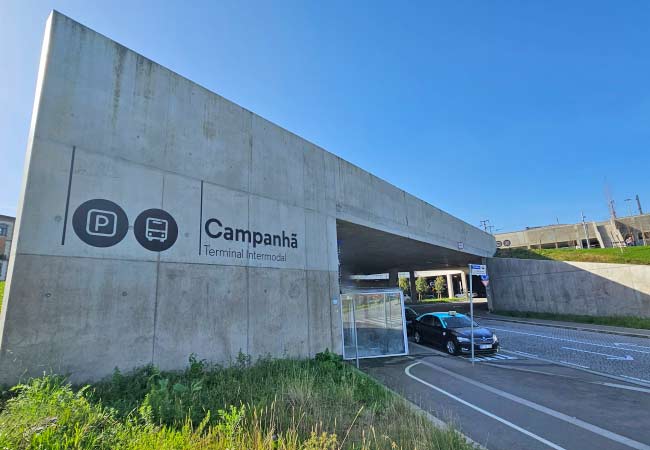
The Terminal Intermodal de Campanhã
In Lisbon, there are two intercity bus stations: Oriente and Sete Rios. All FlixBus services terminate at Oriente, while Rede Expressos services are split between the two bus stations.
Insight: Your ticket will specify the bus station at which you will be arriving.
Oriente bus station is situated in the Parque das Nações district, to the northeast of the city at GPS: 38.767, -9.099). The bus station is connected to the Oriente train station and is served by the red metro line.
Sete Rios bus station is located to the north of Lisbon (GPS: 38.741, -9.166) and is connected to the blue metro line by the Jardim Zoológico metro station.
Bus stations in Portugal are generally safe; however you should remain vigilant when passing through, as pickpockets are always on the lookout for easy opportunities.
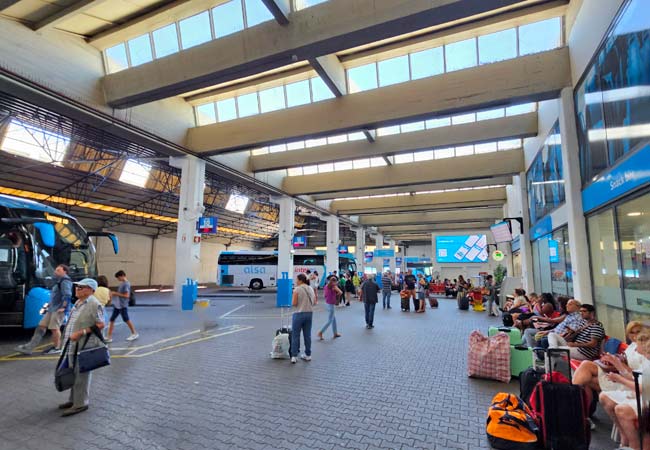
Sete Rios bus station.
Porto to Lisbon by train
There are two classes of train service between Porto and Lisbon: the Alfa Pendular (AP) and the Intercidades (IC). The Alfa Pendular service is faster and offers superior facilities, including free WiFi and more comfortable seats, compared to the older Intercidades trains.
Both train services run directly and depart from/arrive at the same train stations. The train services from Porto to Lisbon are operated by Comboios de Portugal (CP), Portugal’s national rail company.
The Alfa Pendular train journey takes 2 hours and 50 minutes, while the Intercidades takes 3 hours and 15 minutes. There are 14 daily departures in each direction, and the latest timetables can be viewed on the CP website:
www.cp.pt/
(Note: The above link is a PDF and may download automatically on mobile phones)
A single ticket on the Alfa Pendular train from Lisbon to Porto costs €47.40 for Conforto class and €33.90 for standard class, while the Intercidades is priced at €39.75 for first class and €26.85 for second class.
Discounts are available for children (50 per cent off), under 25s (25 per cent off), seniors aged 65 and over (50 per cent off), and when purchasing a return ticket (10 per cent off). If you use any of the age-based discounts, always travel with a valid ID to prove your age.
Train tickets must be pre-booked, as each ticket is for a designated seat. Tickets for popular services often sell out, and there is no standing room on the express trains.
Porto and Lisbon train stations
All trains from Porto to Lisbon depart from Campanhã train station, which is connected to Campanhã bus station.
Note: The express trains do not depart from the São Bento train station, which is close to the historic centre of Porto. It is possible to catch an urban train from São Bento to Campanhã, and this 2km ride is included in your ticket. Often, it is quicker and easier to get an Uber, Bolt or taxi from your accommodation to Campanhã train station.
In Lisbon, all train services stop at Oriente train station, and most terminate at Santa Apolónia.
Insight: The Porto-Lisbon-Algarve express trains do not stop at Santa Apolónia. Therefore, it is advisable to always confirm your departure station on your ticket.
Oriente train station is located to the northeast of Lisbon and is situated in the Parque das Nações district, GPS: 38.7675, -9.099. This is the closest train station to the airport and is served by the red metro line.
Santa Apolónia train station is the final stop on the blue metro. The station has six platforms but is very easy to navigate and has a much calmer atmosphere than Oriente.
Santa Apolónia train station is located on the southern side of the Alfama district (GPS 38.714, -9.122) and is convenient for most visitors, as it is close to the historic centre of Lisbon. If your final destination is in the Baixa, Alfama or Cais do Sodré districts, this station is the preferable option for transit.
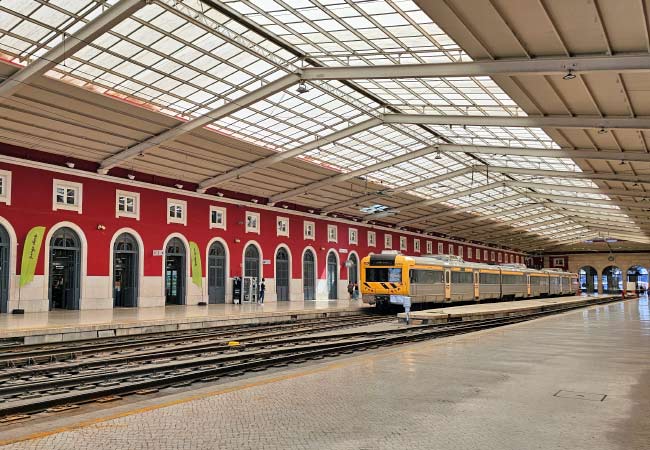
Santa Apolónia is a calm and often quiet train station that is easy to travel through.
Driving from Porto to Lisbon via the A1
The journey from Porto to Lisbon follows the A1 expressway. This expressway is tolled, with the cost being €21.50, which is nearly the same as a train ticket.
Tolls can be paid using the Via Verde transponder, which you should request when renting a car in Portugal. Full details can be found on the Via Verde website:
visitors.viaverde.pt
If you plan to drive a foreign-registered car, please refer to this website:
www.portugaltolls.com/
Having a Via Verde transponder is highly recommended when driving in Portugal, as many expressways only offer automatic toll collection. To estimate the cost of tolls in Portugal, you can use the following website:
https://
If you've found our content valuable, we'd welcome your support.
The digital publishing landscape has evolved significantly. As a small independent publisher, we face growing challenges. Search engines increasingly favour paid content over organic results, while AI-generated content often reproduces original work without attribution.
To support our work, please consider bookmarking this page (press Ctrl + D) for quick access. If you find an article helpful, we'd be grateful if you'd share it with friends on social media.
For specific questions, please see our Reddit community at r/LisbonPortugalTravel.
Should you notice any outdated or incorrect information, please contact us at [email protected]
Thank you for helping us continue to provide valuable content in an increasingly challenging digital environment.






























